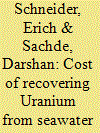| Srl | Item |
| 1 |
ID:
124857


|
|
|
|
|
| Publication |
2013.
|
| Summary/Abstract |
This article provides an independent cost estimate for uranium production from seawater through the braid-type adsorbent recovery system proposed by the Japan Atomic Energy Agency (JAEA). Production costs were developed with standard engineering cost estimation techniques using vendor data and plant design and operational data. The analysis includes life cycle discounted cash flows, economies of scale, and propagation of uncertainties. A reference case based on the Japan Atomic Energy Agency assessment, with a fresh adsorbent capacity of 2 kgU/t ads and 6 recycles, yielded a production cost of $1230/kg uranium with a 95 percent confidence interval of [$1030/kg U, $1430/kg U] when component cost uncertainties alone were considered. Sensitivity studies confirmed that adsorbent capacity, number of recycles, and capacity degradation are major cost drivers. If capacity and number of recycles increases to 6 kg U/t ads and 20, respectively, with no degradation and unchanged adsorbent production costs, the uranium production cost drops to $299/kg U.
|
|
|
|
|
|
|
|
|
|
|
|
|
|
|
|
| 2 |
ID:
075376


|
|
|
|
|
| Publication |
2006.
|
| Summary/Abstract |
The potential role of nuclear fission to meet increased future energy demand while reducing greenhouse gas emissions and controlling nuclear proliferation is assessed. The World Energy Council projection for an environmentally driven future is used, which projects deployment of nearly 3 TW(e) of nuclear generation by 2100, with concurrent reduction of global CO2 emissions to one-third of present levels. We simulate three scenarios based on this demand curve that rely on evolutionary and advanced systems of reactors. The scenarios differ only in fuel cycle choice between once-through, transmutation, and breeding. We show that the cost of nuclear power will likely remain a minimum using the once through fuel cycle, which, we argue, also minimizes proliferation risks. The other two fuel cycle choices have the benefits of decreased waste production and increased uranium resource utilization, but these come at a price that is probably not acceptable unless the cost of repository space increases dramatically, or the cost of building advanced transmuting or breeding reactors can be reduced to a level lower than that of constructing new plants with contemporary technology. The importance of choice of discount rate in allocating resources to advanced nuclear technologies is discussed. The linkage of fuel cycle choice with the international non-proliferation regime is emphasized.
|
|
|
|
|
|
|
|
|
|
|
|
|
|
|
|